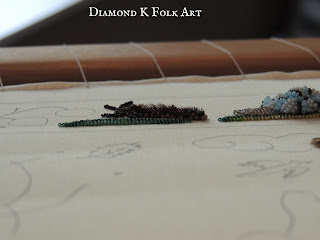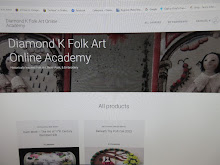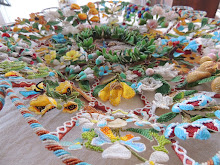Its wonderful being a 'Gatherer'
Earlier this month I took the children home to see Grandma & Grandpa and introduced them to one of my favorite past times.... I come from a good stock of 'Gatherers' as my family puts it... I grew up telling the time of year by what we were picking or hunting for. Peaches......nuts...berries...corn, green beans....you name it we picked it. Where we live now in Colorado, one cannot do this...about the only thing I can forage for here are arrowheads...which is fun, but just not the same as picking something to eat. We had so many fires up in Washington last year, the above picture is a before fire view of our beautiful forest~ you can see how thick it is tho~ really hard to get thru that underbrush...for people or animals both.Last summer hundreds of acres burned here...it burned the guard rails...got so hot it melted the road. For as far as the eye can see...just a black charcoal smudge is left....its really heart breaking to think about...but then again, we get excited, as the one thing that pops right up the next spring after a fire are morel mushrooms. Oh they are soooooo wonderful~ there are still mushroom buyers along side the road ready to buy them...but we never sell the ones we pick....I guess were stingy that way.
To the casual passer by, its just a dead and burned forest, but not really...getting out and walking around in it is dangerous because of the widow makers, but its beautiful too, one can actually walk around where it was so thick before, you just couldnt get in there. There are little green grasses and sprouts coming up all over....
streams still run with crystal clear waters, and the mosses are coming back....this huge root ball was probably 12 feet tall or so~ just huge. And just behind it....
I told the children what to look for, and to keep their noses to the ground in the marshy spots...even among all the dead and burned, there were little oasis' that looked like miniature fairy lands.....and in and among holes and root caves.....there they are! morels! Can you see it? Look center of this picture~ below is another dark hole~ that is a deer track, as they dont eat the morels but another mushroom that grows with it...so one could just follow the deer tracks and find mushrooms. And there were lots of deer tracks, we even saw some moose & elk tracks~ they are really enjoying being able to walk easily thru the forest again.
We spent the day picking our hearts out~ its so much fun to hunt for them~ like an Easter egg hunt, but for something better than an egg! Morels come in several different varieties....some are black as coal, others are blonde. This one looks like velvet, and feels like it to
The children all had fun picking once they figured out what they were looking for. Of coarse Josh was amazed with how big of bark was falling off the dead falls, and him & Emma spent quite a while carting this piece around like a medic's backboard.
Mom & I found this one....one of the blonde types, and good grief, its HUGE~ the biggest morel I have ever seen. They are super good, considered a delicacy and pretty expensive if you want to buy them. They are good battered and fried, or cut up and cooked with chicken(my favorite). They are super easy to keep too~
This is our pickins for the day~ you dont wash them off or anything, just lay them out on a table to dry, and they will shrink and shrink. Once theyre nice and dry, just put them in a zip bag and thats it!
This is just after a day of drying...see how much they shrunk already? To use them, just put them in a bit of salted water, this washes them and they will puff back up to looking like fresh shrooms again!
This wasn't the only thing the children got to pick while were were home....spring is cherry season~ Y*U*M*























































